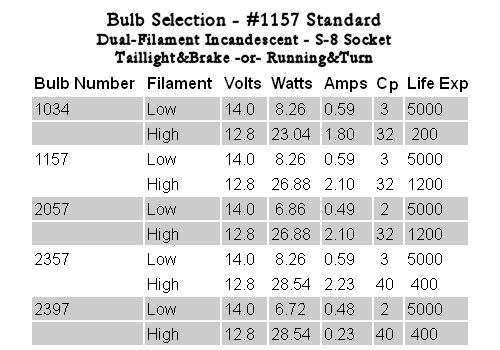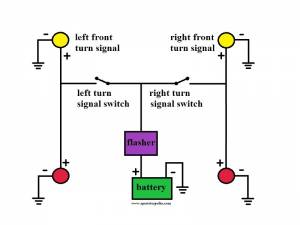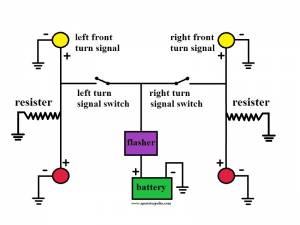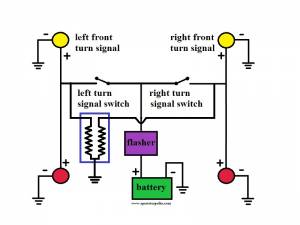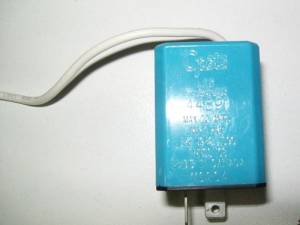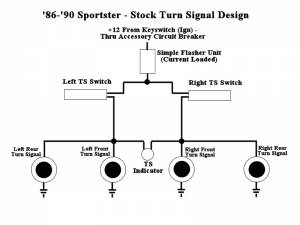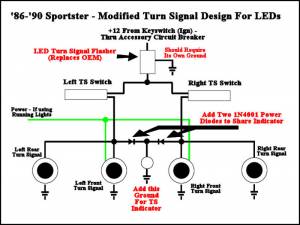Table of Contents
This is an old revision of the document!
REF: Electrical System
Lights - Turn Signals - Bulbs, Mods, Relocating
Turn Signals
LED Lighting
Sub Documents
LEDs are not only highly shock resistant but they have a very long lifetime and can be made quite bright (and in many different colors). 1)
Converting to LED Turn Signals
Selecting and mounting the LED turn signals can be fairly easy with many aftermarket options.
However, they may not simply be straight wired in as the OEM bulbs are.
The recommendation is to use a ‘load balancer’.
If all you do first is replace the bulbs with LED lights, all is normal except the lights don’t blink when you push the turn signal switch.
The root cause is that standard bulbs (app around 20-30 watts and 12-14 volts) draw a couple of amps.
Normal electromechanical flashers need an amp or two to flash on and off.
But LEDs draw only a few milliamps, which is not enough to activate the flashers. Hence the edict to use ‘load balancers’.
A load balancer is nothing but a dummy load (or more simply called a resistor).
By installing a resistor in parallel with your light, the resistor acts as a dummy load drawing the amps you need in order to make the flasher work.
Choosing a resister:
It's important to understand that each incandescent bulb runs 24w when it flashes. 2)
You need a 6-ohm resistor to simulate that equiv load.
Using a resistor rated at 10-watts is definitely going to heat up when you run 24-watts of power through it.
You need a 50-watt resistor because components should be spec'd for twice the rating that they will regularly encounter to provide reliability and safety.
You might get away with cutting corners, sometimes, but it's not a good idea as a policy.
You need one 6-ohm, 50-watt resistor to replace each turn signal bulb (that you either eliminate or replace with LED version or mini-bulbs).
Between 1991 and 2007, the total load that each side of the Turn Signal Module is expecting is 2 x 24w = 48w.
That's what it is designed to function with when blinking the TS lights.
The TSM is designed to expect a certain range of amps being drawn by the lights. 3)
When a bulb burns out, that changes the amp draw and the TSM blinks fast (instead of not blinking at all as in older models) to notify the rider that there is an issue.
Prior to '91, the turn signal flasher was an automotive type with no intelligence.
From 2007 on, most of the TSMs are smart enough to sense and function with whatever the standard load requires.
(whether incandescent, LED or mini-bulb, without adding load resistors)
If you eliminate or replace (with LEDs) both front & back turn signals on the same side, you can parallel two resistors to obtain a 3-ohm load (equiv to two bulbs).
THAT ONLY REQUIRES ONE CONNECTION TO THE TURN SIGNAL LINE for that side of the bike (no terrorizing of the harness is necessary).
Just make one connection, anywhere along the entire TS wiring, for the resistors to replace the bulbs, on that side of the bike.
(VIOLET wire on LEFT side and/or BROWN wire on the RIGHT side with resistors often placed somewhere under the seat)
So fundamentally use the right parts, install in a nice clean, protected method of connection (solder, shrink-wrap, etc).
The 3-wire flashers have their own ground wire and they should require no load of any sort to function.
The addition of two diodes for the indicator bulb in the configuration shown below should guarantee there is no bleed from one circuit to the other. 6)

